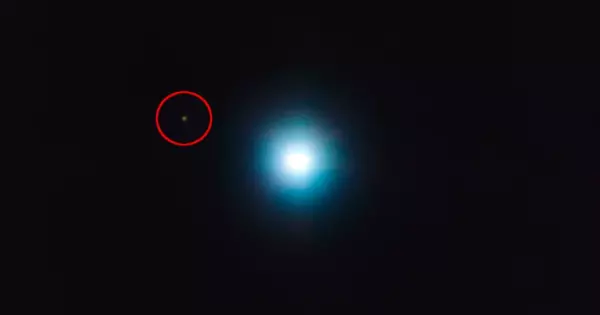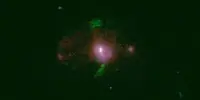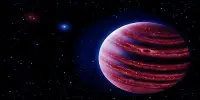Astronomers led by a team from Université de Montréal have made significant progress in understanding the intriguing TRAPPIST-1 exoplanetary system, which was discovered in 2016 amid speculation that it could one day provide a home for humans.
The new study not only sheds light on the nature of TRAPPIST-1 b, the exoplanet closest to the system’s star, but it also demonstrates the importance of parent stars when studying exoplanets.
The findings of astronomers at UdeM’s Trottier Institute for Research on Exoplanets (iREx) and colleagues in Canada, the United Kingdom, and the United States, published in Astrophysical Journal Letters, shed light on the complex interplay between stellar activity and exoplanet characteristics.
This is just a small subset of many more observations of this unique planetary system that remain to be made and analyzed. These first observations highlight the power of NIRISS and the JWST in general to probe the thin atmospheres around rocky planets.
René Doyon
Captured the attention
TRAPPIST-1, a star much smaller and cooler than our sun located about 40 light-years away from Earth, has captivated scientists and space enthusiasts alike since the discovery of seven Earth-sized exoplanets seven years ago. These worlds, which are densely packed around their star, three of which are within its habitable zone, have fueled hopes of discovering potentially habitable environments beyond our solar system.
The researchers, led by iREx doctoral student Olivia Lim, used the powerful James Webb Space Telescope (JWST) to observe TRAPPIST-1 b. During the JWST’s first year of operation, their observations were collected as part of the largest Canadian-led General Observers (GO) program. (Observations of three other planets in the system, TRAPPIST-1 c, g, and h, were also included in this program.) TRAPPIST-1 b was observed by the Canadian-made NIRISS instrument aboard the JWST during two transits (when the planet passes in front of its star).
“These are the first JWST spectroscopic observations of any TRAPPIST-1 planet, and we’ve been waiting for them for years,” said Lim, the GO program’s principal investigator.
She and her colleagues used the technique of transmission spectroscopy to peer deeper into the distant world. By analyzing the central star’s light after it has passed through the exoplanet’s atmosphere during a transit, astronomers can see the unique fingerprint left behind by the molecules and atoms found within that atmosphere.

‘Just a small subset’
“This is just a small subset of many more observations of this unique planetary system that remain to be made and analyzed,” says René Doyon, Principal Investigator of the NIRISS instrument and co-author of the study. “These first observations highlight the power of NIRISS and the JWST in general to probe the thin atmospheres around rocky planets.”
The astronomers’ main discovery was how important stellar activity and contamination are in determining the nature of an exoplanet. The influence of the star’s own features, such as dark spots and bright faculae, on measurements of the exoplanet’s atmosphere is referred to as stellar contamination.
The team found compelling evidence that stellar contamination plays a crucial role in shaping the transmission spectra of TRAPPIST-1 b and, likely, the other planets in the system. The central star’s activity can create “ghost signals” that may fool the observer into thinking they have detected a particular molecule in the exoplanet’s atmosphere.
According to the scientists, this result emphasizes the importance of considering stellar contamination when planning future observations of all exoplanetary systems. This is especially true for systems like TRAPPIST-1, which revolves around a red dwarf star that can be quite active with starspots and frequent flare events.
“In addition to the contamination from stellar spots and faculae, we saw a stellar flare, an unpredictable event during which the star looks brighter for several minutes or hours,” Lim went on to say. “This flare influenced our estimation of the amount of light blocked by the planet.” Such signatures of stellar activity are difficult to model, but we must account for them in order to correctly interpret the data.”
A range of models explored
Based on their collected JWST observations, Lim and her team explored a range of atmospheric models for TRAPPIST-1 b, examining various possible compositions and scenarios.
They discovered that cloud-free, hydrogen-rich atmospheres cannot be ruled out with certainty; in other words, there appears to be no clear, extended atmosphere surrounding TRAPPIST-1 b. The data could not, however, confidently rule out thinner atmospheres, such as those composed of pure water, carbon dioxide, or methane, or an atmosphere similar to that of Titan, Saturn’s moon and the only moon in the Solar System with its own atmosphere.
These findings agree with previous (photometric, rather than spectroscopic) JWST observations of TRAPPIST-1 b with the MIRI instrument. The new research also demonstrates that Canada’s NIRISS instrument is a high-performance, sensitive tool capable of probing for atmospheres on Earth-sized exoplanets at impressive levels.
















